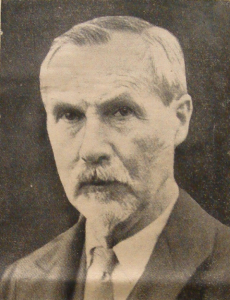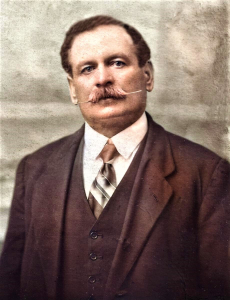The 1922 General Election in Kildare
and the Emergence
of the Political Party System
Published in the Liffey Champion, 29th July
The general election of 1922 was the first election to be held in an independent Irish state and was largely fought over the Anglo-Irish Treaty. But one largely forgotten, and very important aspect of the election is that it resulted in the emergence of a parliamentary party system that has remained with some moderations to the present day. Prior to 1917 there was a two-party system in place, Nationalist and Unionist. Then in 1918 the election was contested by three parties with Sinn Féin entering the fray and winning a historic victory. The local elections in 1920 saw the emergence of a four-party system when Labour contested the election. In 1921, there was yet another election to the Southern Ireland Assembly, but it was boycotted with virtually all nominated candidates returned unopposed.
The Treaty in December 1921 split the Sinn Féin party into two factions with pro-Treaty Sinn Féin and anti-Treaty Sinn Féin emerging as separate political movements. The new Provisional Government in order to comply with the treaty obligations in early 1922, were required to call a General Election to elect a constituent assembly. In many constituencies five political movements were identified which included the two separate Sinn Féin factions, also Labour and Southern Unionists, in addition to well-established independents linked to the defunct Nationalist Party.
This election was held in June 1922 according to proportional representation with constituencies from the 1921 election remaining in place. The constituency of Kildare and Wicklow which was formed by uniting two adjoining counties had elected five TDs in 1921, Donal Buckley and Art O’Connor from the Kildare section and Robert Barton, Erskine Childers and Christopher Byrne from the Wicklow section. The 1922 contest in the constituency produced an unusual outcome with the Kildare section in particular providing a surprising and exceptional result.
Divisive Sinn Féin Campaign
An election campaign by the pro-Treaty Sinn Féin faction in the constituency was launched on the 14th of March 1922 at a meeting in Naas chaired by Christopher Byrne. He was a TD from the Wicklow section of the constituency and the only one of five outgoing Sinn Féin TDs in the constituency that supported the treaty. A full electoral staff was chosen for the joint north and south Kildare regions with the Town Hall, Naas chosen as the headquarters. Divisions were apparent at local level throughout County Kildare where in Naas anti-treaty supporters secured an election room in the Town Hall alongside where supporters of the treaty already had separate accommodation.
In mid-April, the pro-Treaty section received a major boost when Michael Collins and virtually one third of the membership of the Provisional Government attended an election rally in Naas. The meeting, which was chaired by Kilcock county councillor Nicholas Travers attracted an estimated attendance of 3,000 with security provided by the local pro-Treaty IRA. Senior ministers addressing the gathering included: Joe McGrath and Kevin O’Higgins. Christopher Byrne TD was introduced as the one representative for Kildare and Wicklow supporting the treaty. In a calm, common-sense speech, Michael Collins argued that
…the alternative to rejection of the treaty involved the return of the British forces, the renewal of warfare, and the improbability of further negotiation.
The political split was evident at this time with the two TDs representing Kildare, Donal Buckley and Art O’Connor who were on the anti-Treaty side of the divide having no involvement in the meeting.
Meanwhile, preparations for the election by the pro-Treaty side were at an advanced stage. A conference held in the Town Hall Naas, on the 9th of April, selected treaty supporters, Thomas Lawler and James Kavanagh respectively, to contest the North Kildare and West Wicklow districts of the constituency. Then on the 7th of May, a convention held in Kildare town, selected Simon Malone from Rathangan as a candidate for the South Kildare region.
Election Pact
However, divisive electioneering by Sinn Féin soon came to an end due to successful negotiations between the pro-Treaty and anti-Treaty sides. On the 20th of May 1922, Michael Collins and Eamon de Valera approved an election pact which provided for an agreed list of candidates from both sides to fight the general election jointly and form a coalition government afterwards. The pact was described by British historian, Peter Townshend, as ‘pure election-rigging in which the contours of the split would be artificially preserved’.


Art O’Connor & Donal Buckley.
The candidates selected at pro-Treaty conventions in Kildare were required to stand down. A conference on the 29th of May formally selected all four anti-Treaty candidates from the constituency Donal Buckley, Art O’Connor, Hugh Barton and Erskine Childers to contest the election alongside Christopher Byrne. In the Kildare section of the constituency, the two anti-Treaty TDs, Donal Buckley from Maynooth and Art O’Connor from Celbridge, would have a free run with no pro-Treaty Sinn Féin candidate opposing them. However, pro-Treaty Sinn Féin supporters would have the opportunity to support Wicklow based Christopher Byrne.
Anti-Treaty Sinn Féin
In Kildare both sides appeared united, with the pact welcomed by the county council. However, as Buckley and O’Connor began Church gate meetings in their respective constituency districts on the 4th of June some meetings were poorly supported. The opposite was the case on the 14th of June, when Eamon de Valera spoke at a number of public meetings in the county chaired by Simon Malone. At Naas a crowd mainly from the north of the county estimated at 3,000, were addressed by many of the best-known anti-Treaty activists in the country. As well as de Valera, they included Robert Barton, Harry Boland and Austin Stack together with local candidates O’Connor and Buckley. Art O’Connor who had unintentionally insulted farmers in the Dáil during the treaty debates used the opportunity to mend fences by denying claims that he had targeted farmers on that occasion. While de Valera was campaigning for all the panel candidates at meetings in Kildare, Michael Collins, under pressure from the British government, which regarded the pact as a violation of the treaty, virtually repudiated the pact at an election meeting in Cork when he specifically urged support for pro-Treaty candidates.
Labour Party
The Labour movement emerged in the post treaty period as the most efficient political organisation in County Kildare. It had strong representation on all the local authority boards, enjoying considerable support in both the urban and rural areas particularly the towns of Newbridge and Athy. Leading individuals associated with the movement included, Michael Smyth, William Cummins and Hugh Colohan from Newbridge who had emerged as the principal spokesman for the party in Kildare.
On the 26th of March, a meeting of eight local Trade Unions was held in Newbridge and a decision to contest the election was carried. Then, on the 9th of April, a County Kildare Labour Conference selected Hugh Colohan to join James Everett from Wicklow on the ticket. Colohan indicated that it was time for the country to get on with practical work by suggesting that ‘the rule of the gun should give way to the rule of the spade’.
Farmers Party
The Farmers Union were well-organised throughout the county with a membership that included former Redmondite Nationalists and Unionists who were not affiliated to any political party.
Local Unionists had moved quickly to recognise the new Provisional Government following the treaty. Lord Mayo, the leading Kildare Unionist personally organised a meeting of fellow Unionists in Dublin on the 19th of January which endorsed the treaty and offered support to the new Provisional Government.
Farmers in Kildare were not normally supporters of Sinn Féin. They also had robust links to the Ratepayers Association, an urbanised movement which campaigned for a reduction of rates. The Farmers Union in the south of the county facilitated the formation of Athy Ratepayers Association in 1921. This branch, which included former nationalists among its membership, unanimously endorsed John Bergin, a prominent member of Athy Farmers Union, as a Ratepayers candidate.
A county convention organised by the Farmers Union attended by more than sixty delegates with an almost equal divide from the north and south of the county, was held in Naas on the 31st of May and decided to contest the election as a Farmers and Ratepayers Party. Two candidates, John Bergin from Athy and Patrick Phelan, a county councillor from Timahoe, were selected and joined on the ticket by Richard Wilson who was already nominated by County Wicklow constituents. The party also received support from former Unionists who constituted a substantial membership of the Farmers Union.
General Election of 1922 in Kildare
With violence and intimidation a common factor in the run-up to the election on the 16th of June, there was no intimidation by either wings of Sinn Féin of opposing candidates in the constituency of Kildare – Wicklow. The election was generally peaceful although there were some incidents such as in Castledermot where an anti-Treaty IRA Volunteer, was accidentally shot dead by the National army as they cleared a hall when voting had ended.
As expected, the election resulted in a resounding victory for candidates favouring the treaty who won eighty-one percent of the vote. Christopher Byrne, pro-Treaty Sinn Féin, topped the poll with 9,170 first preferences – more than one and a half quotas. Labour candidates Hugh Colohan and James Everett also exceeded the quota. Colohan’s 6,522 votes was a mere forty-six votes less than the combined four anti-Treaty candidates who had a disastrous day. Robert Barton, ironically a signatory of the treaty, was the only one of four anti-Treaty candidates elected. The combined Farmers and Ratepayers Party obtained a respectable vote of 6,261, a mere 307 votes less than the anti-Treaty vote, which was enough to elect Richard Wilson.
A substantial pro-Treaty Sinn Féin vote from Kildare went to Christopher Byrne while preferences from Kildare farmers helped to elect Richard Wilson.
Labour’s Hugh Colohan who had never been a member of Sinn Féin or the IRA was the only resident from County Kildare elected to the Dáil. Kildare therefore was the only county in the Irish Free State where no Sinn Féin member or outgoing TD had been elected. Colohan became the first TD from Kildare to sit in Leinster House the new seat of Dáil Éireann. His support came mainly from Newbridge which suffered unemployment due to the departure of the British army, who had been one of the biggest employers in the county. But he also obtained support from Leixlip and Celbridge which had suffered as a result of the lock out strike in 1913 some 9 years previous.
The present party-political system to a large extent originated during the 1922 election campaign. But another factor in the election most notably in Kildare and Wicklow was a trend to move away from revolutionary objectives and principles that had been hard fought for over the previous ten years.
The next election would produce an even more conservative result.
Sources
- Charles Townsend, The Republic: The Fight for Irish independence, 1918–1923 (London, 2013), p. 398
- Seamus Cullen, Kildare: The Irish Revolution 1912–23 (Dublin, 2020), pp 102–5
- Seamus Cullen, ‘Loyalists in a Garrison County: Kildare, 1912–23’ in Brian Hughes and Conor Morrissey, (eds.), Southern Irish Loyalism, 1912–1949 (Liverpool, 2020), p. 260

